Schützenfest – Germany’s Traditional Marksmen Festival
Schützenfest — literally, “marksmen’s festival.” It takes place in almost every village and town around here, but this year I finally witnessed its most spectacular chapter — the Royal Parade.
Long ago, the land we now call Germany was a mess of tiny kingdoms constantly being shuffled by wars — some brief, some catastrophic. There was no central army, no police, and certainly no “call 112 for everything.” Villages had to fend for themselves.
Each one had its own armed militia — the Schützengilde — made up of regular folks. And since swinging a musket around needs some skill, these citizen-soldiers practiced shooting regularly. And where there’s practice, competitions soon follow. So once a year, they’d gather to shoot at a wooden bird, crown the winner as king, and then drink themselves into legend.
Napoleonic wars brought the fashion of military “specializations”: grenadiers, riflemen, sappers — and that whole martial romance stuck. By the 20th century, with the rise of a unified German state and a professional army, Schützenfest gradually turned from militia duty into something more like a cultural carnival.
But the centuries-old tradition didn’t go anywhere. In many regions, Schützenfest is the biggest event of the year — and that’s not an exaggeration.
At its heart, now as then, is the shooting of the wooden bird. A crowd gathers at a designated spot, and one by one, the contenders fire at it. The one who knocks it down is crowned the Schützenkönig — the King of Marksmen.
But this being Germany, of course it doesn’t stop there. The whole event spans several days, with a packed schedule of rituals and ceremonies.
Saturday, the participants starch their uniforms, polish their medals, and gather for the ceremonial opening. They march through town and solemnly lay wreaths at the local war memorial. Come evening: a torchlit ritual followed by a wild celebration that can be heard echoing through several postal codes and doesn’t end before midnight. Trust me — I couldn’t fall asleep last Saturday due to the music, and it wasn’t even my village. The whole town gets involved — kids’ rides and carnival stalls pop up in the parking lot near the station, food tents serve everything greasy, and a giant beer tent hosts the gunmen.
Sunday, slightly dented but far from broken, the marksmen reassemble for the Royal Parade. They march several circuits through the village, ending with a grand pass-by in front of the reviewing stand: the king, the mayor, and a couple dozen of the local elite. Some divisions already look like they’re sweating beer, and they march straight from the parade to the next chapter of drinks.
Monday morning, the wooden bird is hoisted, and the shooting tournament begins. In the evening — yet another parade, less formal this time, followed by yet another round of beer rivers and sausage mountains. This time, the reason is the crowning of the new king, who’ll now spend the year attending every possible event — draining his wallet and his liver.
Tuesday is for everyone else — schoolkids and assorted non-royals. Kids can compete to become Prince of Marksmen, by the way. The final march in the evening is much more relaxed, and they finish off whatever supplies are left from the previous days. That’s the end of the festival.
I attended the main parade, and honestly — it was a spectacle of ridiculous scale. For a village of 7,000 people, there were five marching bands, dozens of divisions (each 10–20 strong, but still!), and a huge crowd of onlookers from nearby towns. Horses, polished breastplates, feathered helmets, flower bouquets larger than I am, and uniforms in every color imaginable. A historical reenactment? A flash of militarism? Or just a multi-day excuse to party until the ground shakes? Maybe all of that — and then some.
I brought back a couple dozen amazing photos. It was sunny, I showed up early, and had the perfect vantage point. Choosing just a few shots for a blog post wasn’t easy.
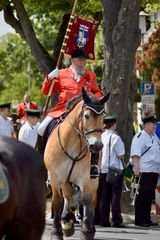
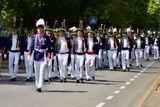
The march through the village streets before the main parade.
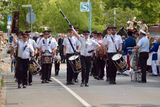
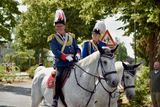
Oberst — the Colonel. He’s second in command after the King of Marksmen.
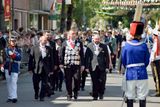
And here’s the King himself, reviewing the troops before the parade. Behind him in the blue hat — our very own Madam Mayor.
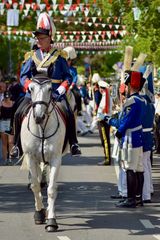
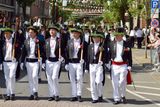
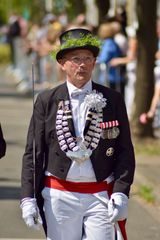
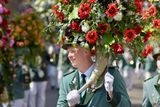
These massive flower bouquets — about half the size of a person — are part of the tradition, symbolizing fertility and abundance.

Heavy cavalry — cuirassiers on gigantic draft horses. In the middle, the banner of the local shooting guild.
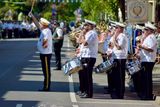
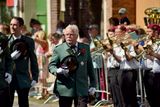
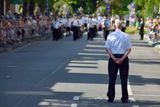

Is it worth going? The Royal Parade? Absolutely. The drums make your heart beat off-rhythm, and the flutes shake your fillings loose. You feel a strange urge to join this human tide — if not in uniform, then at least by waving madly at the marching columns. The wooden rifles with roses in the barrels and the silver-haired marksmen in uniforms may look a bit silly… but damn, they take it seriously. And those cuirassiers in full armor, shining in the sun — it’s pure might, until a little voice from the crowd yells “Papa!” and the horse trots over to the curb.
Yes, that’s Schützenfest for you. Tradition, pageantry, beer — and the biggest party of the year.